air condition Lancia Thesis 2006 Owner handbook (in English)
[x] Cancel search | Manufacturer: LANCIA, Model Year: 2006, Model line: Thesis, Model: Lancia Thesis 2006Pages: 386, PDF Size: 8.69 MB
Page 60 of 386
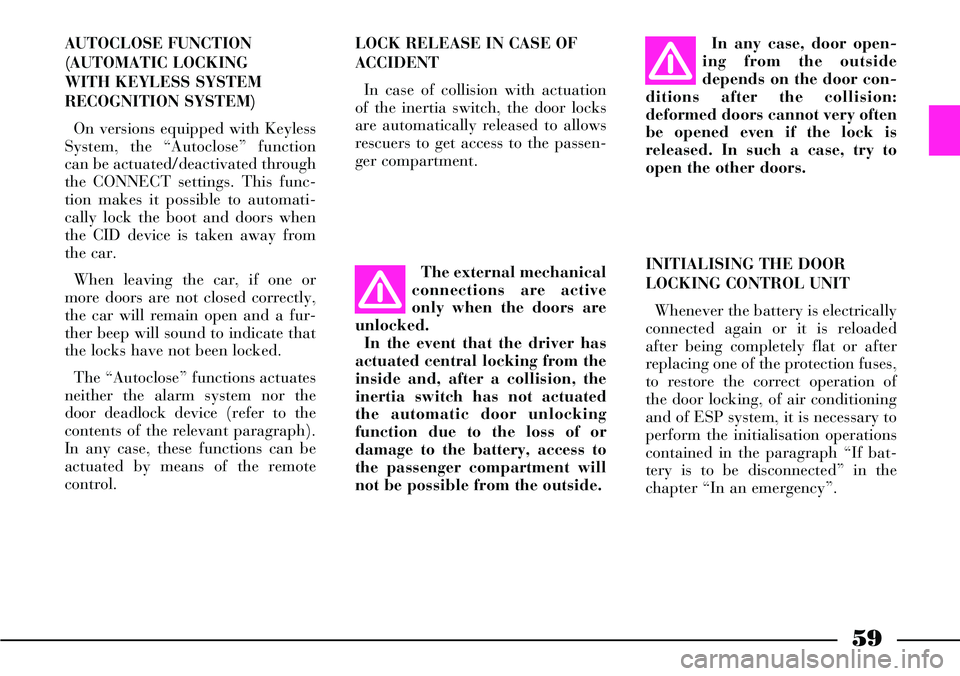
59
AUTOCLOSE FUNCTION
(AUTOMATIC LOCKING
WITH KEYLESS SYSTEM
RECOGNITION SYSTEM)
On versions equipped with Keyless
System, the “Autoclose” function
can be actuated/deactivated through
the CONNECT settings. This func-
tion makes it possible to automati-
cally lock the boot and doors when
the CID device is taken away from
the car.
When leaving the car, if one or
more doors are not closed correctly,
the car will remain open and a fur-
ther beep will sound to indicate that
the locks have not been locked.
The “Autoclose” functions actuates
neither the alarm system nor the
door deadlock device (refer to the
contents of the relevant paragraph).
In any case, these functions can be
actuated by means of the remote
control.LOCK RELEASE IN CASE OF
ACCIDENT
In case of collision with actuation
of the inertia switch, the door locks
are automatically released to allows
rescuers to get access to the passen-
ger compartment.In any case, door open-
ing from the outside
depends on the door con-
ditions after the collision:
deformed doors cannot very often
be opened even if the lock is
released. In such a case, try to
open the other doors.
INITIALISING THE DOOR
LOCKING CONTROL UNIT
Whenever the battery is electrically
connected again or it is reloaded
after being completely flat or after
replacing one of the protection fuses,
to restore the correct operation of
the door locking, of air conditioning
and of ESP system, it is necessary to
perform the initialisation operations
contained in the paragraph “If bat-
tery is to be disconnected” in the
chapter “In an emergency”. The external mechanical
connections are active
only when the doors are
unlocked.
In the event that the driver has
actuated central locking from the
inside and, after a collision, the
inertia switch has not actuated
the automatic door unlocking
function due to the loss of or
damage to the battery, access to
the passenger compartment will
not be possible from the outside.
Page 94 of 386

IMPORTANT If the ¬warning
light does not turn on when turning
the ignition key to MARor if it stays
on when travelling, (together with
message on display) this could indi-
cate a failure in safety retaining sys-
tems; under this condition air bags
or pretensioners could not trigger in
the event of collision or, in a restrict-
ed number of cases, they could trig-
ger accidentally. Stop the car and
contact Lancia Dealershipto have
the system checked immediately.
The air bag system has a validity of
14 years as concerns the pyrotechnic
charge and 10 years as concerns the
coil contact (see the plate on the front
let door). As these dates approach, con-
tact Lancia Dealershipto have them
replaced.
IMPORTANTAfter an accident
which triggered the airbags, go to a
Lancia Dealershipto have the
entire safety system, the electronic
control unit, the seat belts and the
pretensioners replaced and to have
the electrical system checked. Never lean head, arms
and elbows out of the
window.Operation of the front bags is not
disabled by the passenger’s front
airbag and rear side bag deactiva-
tion switch.
IMPORTANTIn the event of side
crash, you can obtain the best pro-
tection by the system keeping a cor-
rect position on the seat, allowing
thus a correct window bag unfold-
ing.IMPORTANTThe front airbags
and/or front and rear side bags can
be triggered if the car is involved in
hard impacts or collisions in the area
of the underbody, such as for exam-
ple violent impacts against steps,
kerbs or projecting objects fixed to
the ground or if the car falls into
large pot-holes or dips in the road
surface.
IMPORTANTWhen the airbag is
fired it emits a small amount of
powder and smoke. This is not
harmful and does not indicate the
beginning of a fire. Furthermore the
surface of the inflated bag and the
passenger compartment may be cov-
ered with powder residues. This
powder may irritate skin and eyes.
In the event of exposure, wash with
mild soap and water.
93
Never rest head, arms
and elbows on the door,
on the windows and in the
window bag area to prevent pos-
sible injuries during the inflation
phase.
Page 96 of 386
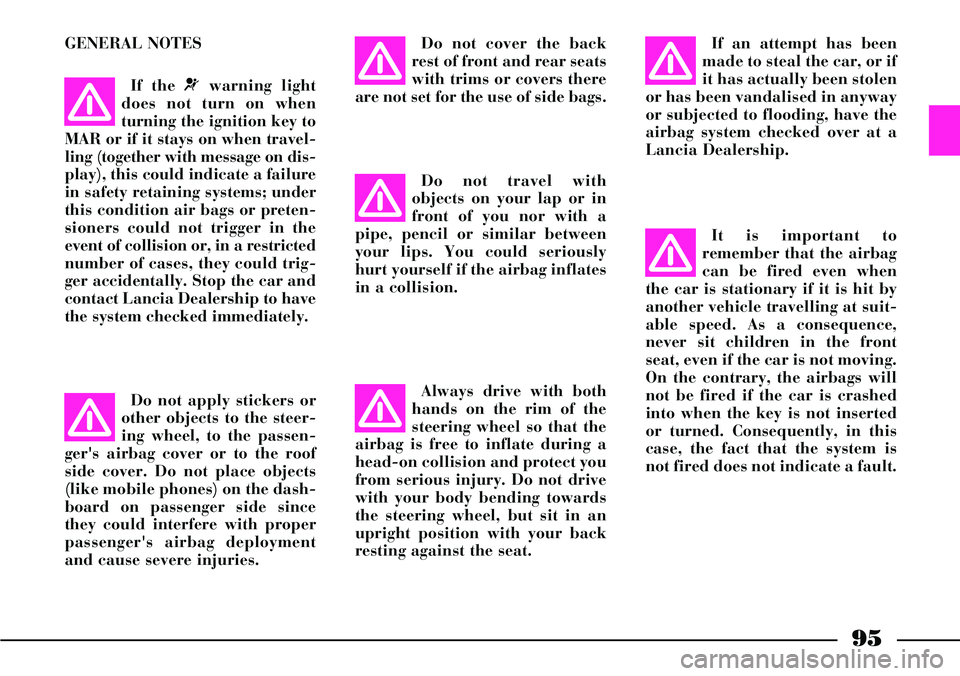
95
GENERAL NOTES
Do not apply stickers or
other objects to the steer-
ing wheel, to the passen-
ger's airbag cover or to the roof
side cover. Do not place objects
(like mobile phones) on the dash-
board on passenger side since
they could interfere with proper
passenger's airbag deployment
and cause severe injuries.
If the ¬warning light
does not turn on when
turning the ignition key to
MAR or if it stays on when travel-
ling (together with message on dis-
play), this could indicate a failure
in safety retaining systems; under
this condition air bags or preten-
sioners could not trigger in the
event of collision or, in a restricted
number of cases, they could trig-
ger accidentally. Stop the car and
contact Lancia Dealership to have
the system checked immediately.
Do not cover the back
rest of front and rear seats
with trims or covers there
are not set for the use of side bags.
Do not travel with
objects on your lap or in
front of you nor with a
pipe, pencil or similar between
your lips. You could seriously
hurt yourself if the airbag inflates
in a collision.
Always drive with both
hands on the rim of the
steering wheel so that the
airbag is free to inflate during a
head-on collision and protect you
from serious injury. Do not drive
with your body bending towards
the steering wheel, but sit in an
upright position with your back
resting against the seat.If an attempt has been
made to steal the car, or if
it has actually been stolen
or has been vandalised in anyway
or subjected to flooding, have the
airbag system checked over at a
Lancia Dealership.
It is important to
remember that the airbag
can be fired even when
the car is stationary if it is hit by
another vehicle travelling at suit-
able speed. As a consequence,
never sit children in the front
seat, even if the car is not moving.
On the contrary, the airbags will
not be fired if the car is crashed
into when the key is not inserted
or turned. Consequently, in this
case, the fact that the system is
not fired does not indicate a fault.
Page 118 of 386
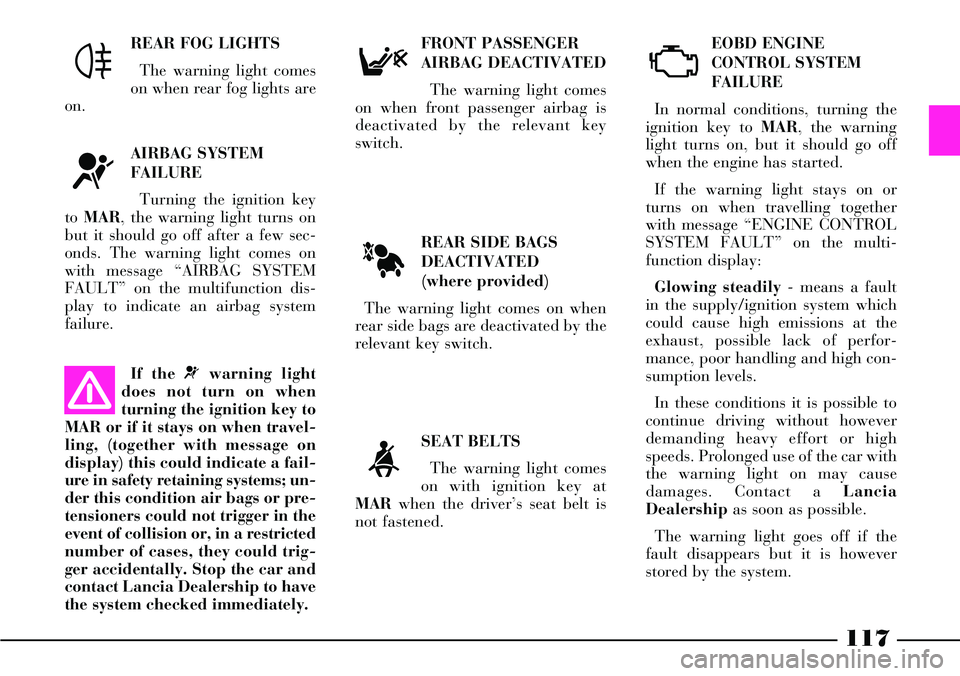
117
REAR SIDE BAGS
DEACTIVATED
(where provided)
The warning light comes on when
rear side bags are deactivated by the
relevant key switch.EOBD ENGINE
CONTROL SYSTEM
FAILURE
In normal conditions, turning the
ignition key to MAR, the warning
light turns on, but it should go off
when the engine has started.
If the warning light stays on or
turns on when travelling together
with message “ENGINE CONTROL
SYSTEM FAULT” on the multi-
function display:
Glowing steadily- means a fault
in the supply/ignition system which
could cause high emissions at the
exhaust, possible lack of perfor-
mance, poor handling and high con-
sumption levels.
In these conditions it is possible to
continue driving without however
demanding heavy effort or high
speeds. Prolonged use of the car with
the warning light on may cause
damages. Contact a Lancia
Dealershipas soon as possible.
The warning light goes off if the
fault disappears but it is however
stored by the system. FRONT PASSENGER
AIRBAG DEACTIVATED
The warning light comes
on when front passenger airbag is
deactivated by the relevant key
switch.
SEAT BELTS
The warning light comes
on with ignition key at
MARwhen the driver’s seat belt is
not fastened.
F
<
U
À
REAR FOG LIGHTS
The warning light comes
on when rear fog lights are
on.
AIRBAG SYSTEM
FAILURE
Turning the ignition key
to MAR, the warning light turns on
but it should go off after a few sec-
onds. The warning light comes on
with message “AIRBAG SYSTEM
FAULT” on the multifunction dis-
play to indicate an airbag system
failure.
4
¬
If the ¬warning light
does not turn on when
turning the ignition key to
MAR or if it stays on when travel-
ling, (together with message on
display) this could indicate a fail-
ure in safety retaining systems; un-
der this condition air bags or pre-
tensioners could not trigger in the
event of collision or, in a restricted
number of cases, they could trig-
ger accidentally. Stop the car and
contact Lancia Dealership to have
the system checked immediately.
Page 128 of 386

Action
IMPORTANTIf the ¬warning light
does not turn on when turning the ig-
nition key to MARor if it stays on
when travelling, (together with mes-
sage on display) this could indicate a
failure in safety retaining systems; un-
der this condition air bags or preten-
sioners could not trigger in the event of
collision or, in a restricted number of
cases, they could trigger accidentally.
Stop the car and contact Lancia Deal-
ershipto have the system checked im-
mediately.
127
Outside temperature (ice hazard)
Warning light/symbol
❄
Message
WARNING ICE HAZARDMeaning of the message
Outside temperature is low
and there could be ice on the roadRemarks
Under certain conditions
(bridges, overbridges,
curves or road sections in
the shade, etc.) the air temperature
at ground level can be lower than
that at sensor level and therefore
there can be ice on the road
although this warning message is
not displayed
Message
AIRBAG SYSTEM
FAULT
AIRBAG SYSTEM
FAULT
SWITCH OFF ENGINE,
DO NOT PROCEEDMeaning of the message
Airbag system
failure
Airbag system
failure
Airbag
Warning light/symbol
¬
Page 148 of 386
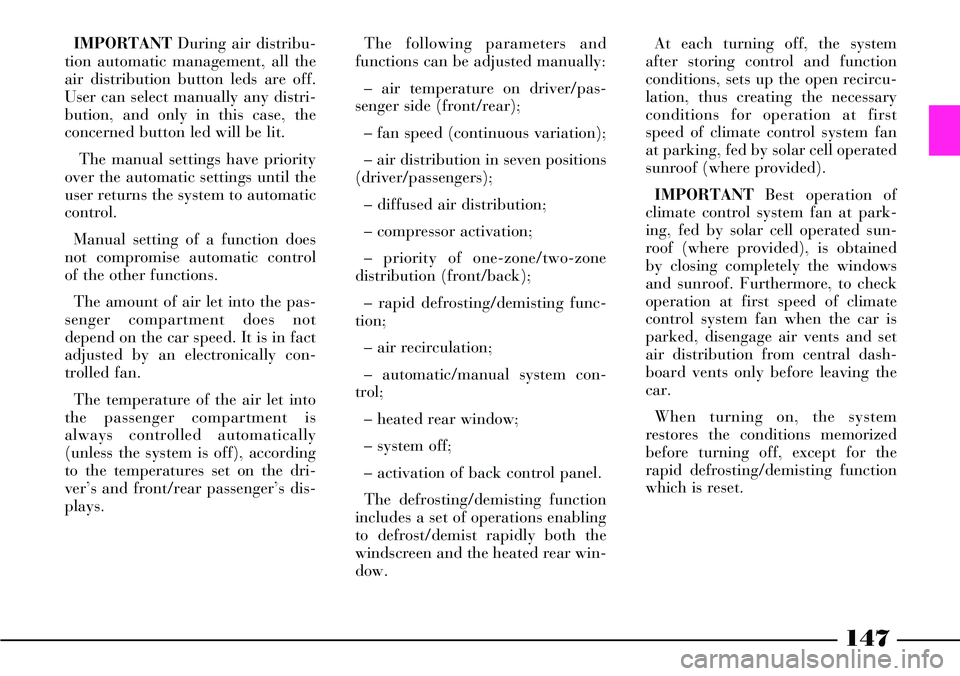
147
IMPORTANTDuring air distribu-
tion automatic management, all the
air distribution button leds are off.
User can select manually any distri-
bution, and only in this case, the
concerned button led will be lit.
The manual settings have priority
over the automatic settings until the
user returns the system to automatic
control.
Manual setting of a function does
not compromise automatic control
of the other functions.
The amount of air let into the pas-
senger compartment does not
depend on the car speed. It is in fact
adjusted by an electronically con-
trolled fan.
The temperature of the air let into
the passenger compartment is
always controlled automatically
(unless the system is off), according
to the temperatures set on the dri-
ver’s and front/rear passenger’s dis-
plays.The following parameters and
functions can be adjusted manually:
– air temperature on driver/pas-
senger side (front/rear);
– fan speed (continuous variation);
– air distribution in seven positions
(driver/passengers);
– diffused air distribution;
– compressor activation;
– priority of one-zone/two-zone
distribution (front/back);
– rapid defrosting/demisting func-
tion;
– air recirculation;
– automatic/manual system con-
trol;
– heated rear window;
– system off;
– activation of back control panel.
The defrosting/demisting function
includes a set of operations enabling
to defrost/demist rapidly both the
windscreen and the heated rear win-
dow.At each turning off, the system
after storing control and function
conditions, sets up the open recircu-
lation, thus creating the necessary
conditions for operation at first
speed of climate control system fan
at parking, fed by solar cell operated
sunroof (where provided).
IMPORTANTBest operation of
climate control system fan at park-
ing, fed by solar cell operated sun-
roof (where provided), is obtained
by closing completely the windows
and sunroof. Furthermore, to check
operation at first speed of climate
control system fan when the car is
parked, disengage air vents and set
air distribution from central dash-
board vents only before leaving the
car.
When turning on, the system
restores the conditions memorized
before turning off, except for the
rapid defrosting/demisting function
which is reset.
Page 149 of 386

148
FRONT CONTROL PANEL (fig. 121)
fig. 121L0A0054b
INITIALISING THE AIR
CONDITIONING CONTROL UNIT
Whenever the battery is electrically
connected again or it is reloaded
after being completely flat or after
replacing one of the protection fuses,
to restore the correct operation of
the air conditioning, of the door
locking and of the ESP system. It is
necessary to perform the initialisa-
tion operations contained in the
paragraph “If battery is to be dis-
connected” in the chapter “In an
emergency”.
Page 150 of 386
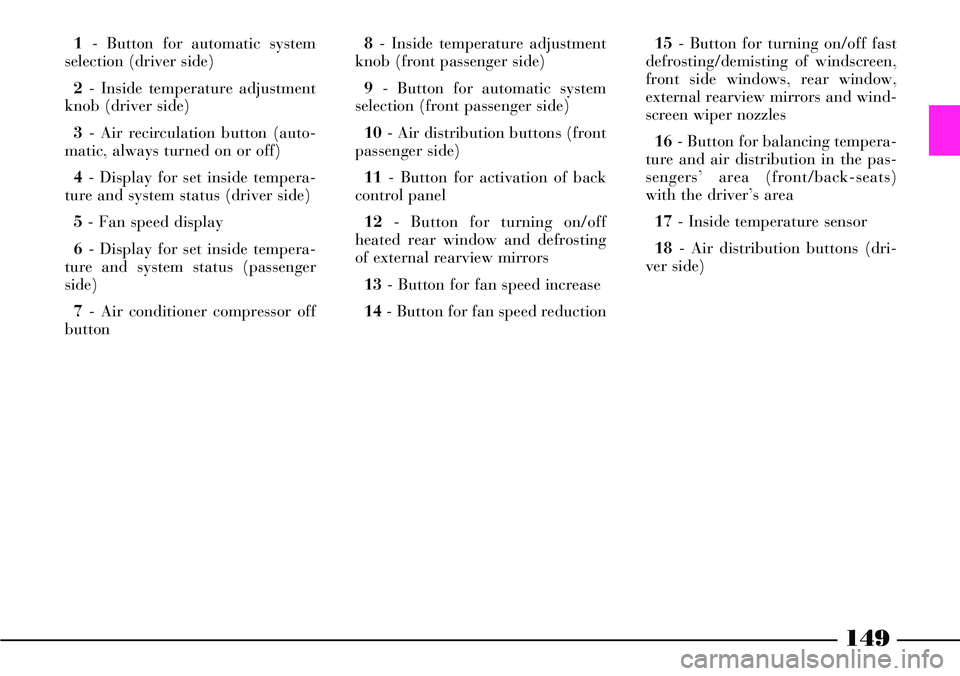
149
1- Button for automatic system
selection (driver side)
2- Inside temperature adjustment
knob (driver side)
3- Air recirculation button (auto-
matic, always turned on or off)
4- Display for set inside tempera-
ture and system status (driver side)
5- Fan speed display
6- Display for set inside tempera-
ture and system status (passenger
side)
7- Air conditioner compressor off
button 8- Inside temperature adjustment
knob (front passenger side)
9- Button for automatic system
selection (front passenger side)
10- Air distribution buttons (front
passenger side)
11- Button for activation of back
control panel
12- Button for turning on/off
heated rear window and defrosting
of external rearview mirrors
13- Button for fan speed increase
14- Button for fan speed reduction15- Button for turning on/off fast
defrosting/demisting of windscreen,
front side windows, rear window,
external rearview mirrors and wind-
screen wiper nozzles
16- Button for balancing tempera-
ture and air distribution in the pas-
sengers’ area (front/back-seats)
with the driver’s area
17- Inside temperature sensor
18- Air distribution buttons (dri-
ver side)
Page 152 of 386
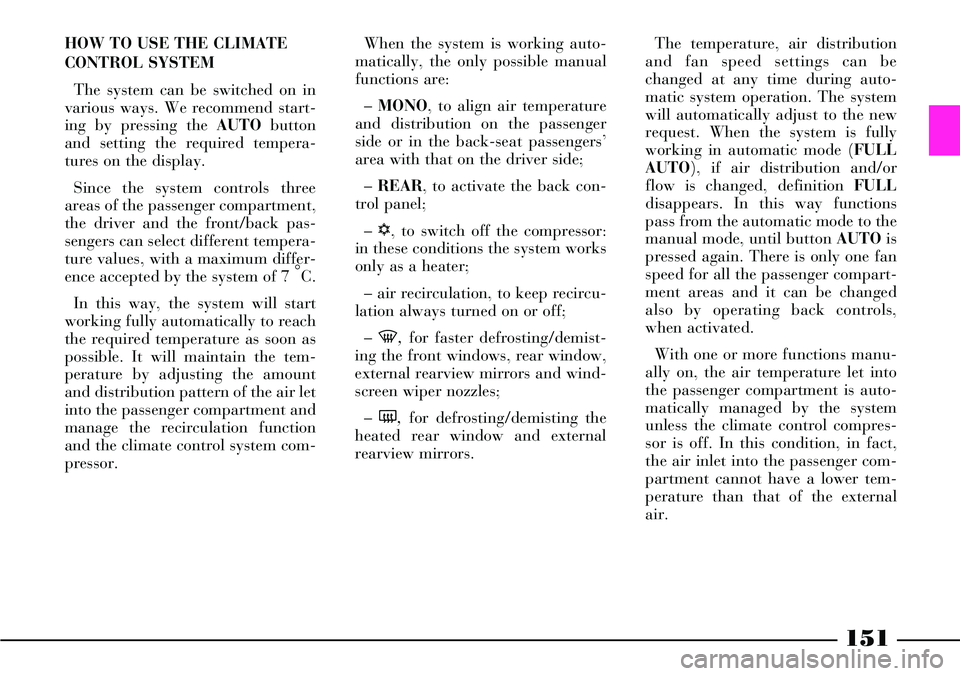
151
HOW TO USE THE CLIMATE
CONTROL SYSTEM
The system can be switched on in
various ways. We recommend start-
ing by pressing the AUTObutton
and setting the required tempera-
tures on the display.
Since the system controls three
areas of the passenger compartment,
the driver and the front/back pas-
sengers can select different tempera-
ture values, with a maximum differ-
ence accepted by the system of 7 °
C.
In this way, the system will start
working fully automatically to reach
the required temperature as soon as
possible. It will maintain the tem-
perature by adjusting the amount
and distribution pattern of the air let
into the passenger compartment and
manage the recirculation function
and the climate control system com-
pressor.When the system is working auto-
matically, the only possible manual
functions are:
– MONO, to align air temperature
and distribution on the passenger
side or in the back-seat passengers’
area with that on the driver side;
– REAR, to activate the back con-
trol panel;
– √, to switch off the compressor:
in these conditions the system works
only as a heater;
– air recirculation, to keep recircu-
lation always turned on or off;
–-, for faster defrosting/demist-
ing the front windows, rear window,
external rearview mirrors and wind-
screen wiper nozzles;
– (,for defrosting/demisting the
heated rear window and external
rearview mirrors.The temperature, air distribution
and fan speed settings can be
changed at any time during auto-
matic system operation. The system
will automatically adjust to the new
request. When the system is fully
working in automatic mode (FULL
AUTO), if air distribution and/or
flow is changed, definition FULL
disappears. In this way functions
pass from the automatic mode to the
manual mode, until button AUTOis
pressed again. There is only one fan
speed for all the passenger compart-
ment areas and it can be changed
also by operating back controls,
when activated.
With one or more functions manu-
ally on, the air temperature let into
the passenger compartment is auto-
matically managed by the system
unless the climate control compres-
sor is off. In this condition, in fact,
the air inlet into the passenger com-
partment cannot have a lower tem-
perature than that of the external
air.
Page 153 of 386
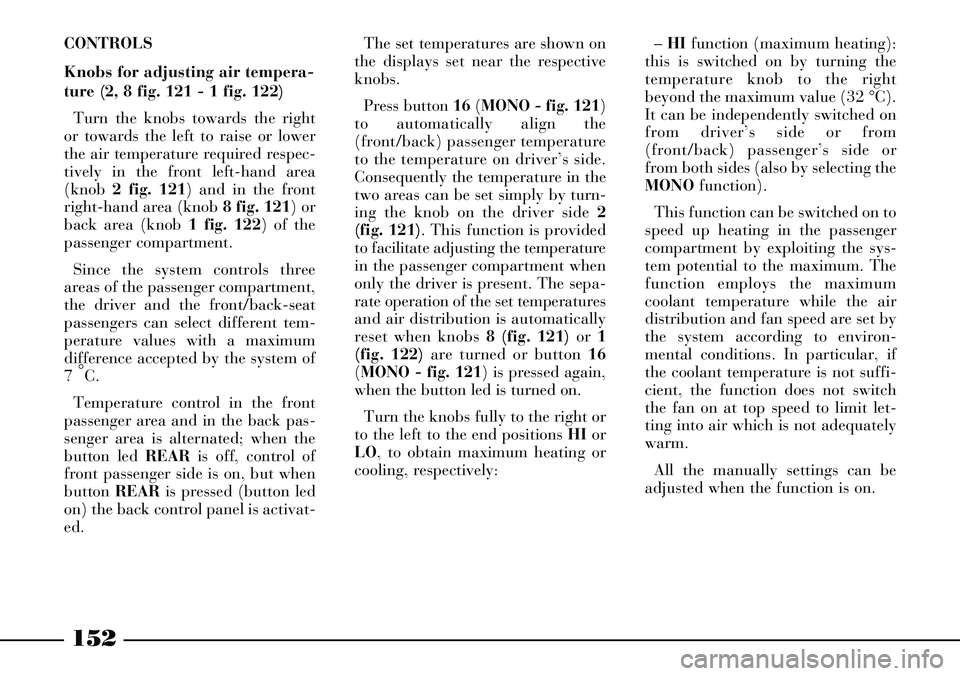
152
CONTROLS
Knobs for adjusting air tempera-
ture (2, 8 fig. 121 - 1 fig. 122)
Turn the knobs towards the right
or towards the left to raise or lower
the air temperature required respec-
tively in the front left-hand area
(knob 2 fig. 121) and in the front
right-hand area (knob 8 fig. 121) or
back area (knob 1 fig. 122) of the
passenger compartment.
Since the system controls three
areas of the passenger compartment,
the driver and the front/back-seat
passengers can select different tem-
perature values with a maximum
difference accepted by the system of
7 °
C.
Temperature control in the front
passenger area and in the back pas-
senger area is alternated; when the
button led REARis off, control of
front passenger side is on, but when
button REARis pressed (button led
on) the back control panel is activat-
ed. The set temperatures are shown on
the displays set near the respective
knobs.
Press button 16(MONO - fig. 121)
to automatically align the
(front/back) passenger temperature
to the temperature on driver’s side.
Consequently the temperature in the
two areas can be set simply by turn-
ing the knob on the driver side 2
(fig. 121). This function is provided
to facilitate adjusting the temperature
in the passenger compartment when
only the driver is present. The sepa-
rate operation of the set temperatures
and air distribution is automatically
reset when knobs 8 (fig. 121) or 1
(fig. 122) are turned or button 16
(MONO - fig. 121) is pressed again,
when the button led is turned on.
Turn the knobs fully to the right or
to the left to the end positions HIor
LO, to obtain maximum heating or
cooling, respectively:– HIfunction (maximum heating):
this is switched on by turning the
temperature knob to the right
beyond the maximum value (32 °C).
It can be independently switched on
from driver’s side or from
(front/back) passenger’s side or
from both sides (also by selecting the
MONOfunction).
This function can be switched on to
speed up heating in the passenger
compartment by exploiting the sys-
tem potential to the maximum. The
function employs the maximum
coolant temperature while the air
distribution and fan speed are set by
the system according to environ-
mental conditions. In particular, if
the coolant temperature is not suffi-
cient, the function does not switch
the fan on at top speed to limit let-
ting into air which is not adequately
warm.
All the manually settings can be
adjusted when the function is on.